

 |
 |
|
|
Jerusalem
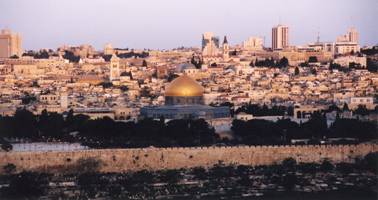
The centerpiece of the Holy Land is, of course, Jerusalem. Tours in Jerusalem include comprehensive walking tours of the Old City with all the Christian shrines along the Via Dolorosa including the Church of the Holy Sepulcher with Calvary and the Tomb of Christ, the Dome of the Rock and the Al-Aqsa Mosque, the Western (wailing) Wall, the restored Jewish Quarter, the Cardo Maxima, the Citadel, and David's Tomb. The Mount of Olives includes the place of Christ's Ascension, the Church of the Lord's Prayer, Dominus Flevit Church, the Garden of Gethsemane and the Basilica of All Nations. Mount Zion includes the Church of St. Peter of the Cockcrowing, the Dormition Abbey, the Upper Room, and Zion Gate.
One can visit the Garden Tomb and Gordon's Calvary. In West Jerusalem, one can visit the Israel Museum and the Shrine of the Book, the model of 2nd Temple, Ein Karem, the Chagall Windows in the Hadassah Hospital, and the business and government district of Israeli Jerusalem.
· The Holy Sepulcher
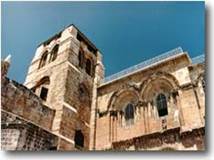
Built by Emperor Constantine in 335 A.D. on the very site of Christ's resurrection, the Holy Sepulchre houses the Calvary or Golgotha and the tomb of Christ. The building was destroyed in successive wars, transformed in the Persian period and finally rebuilt by the Crusaders.
During restorations following the fire of 1808 and the earthquake of 1927, it was possible to determine the topography of the Golgotha and the tomb of Christ.
The Holy Sepulchre has private and communal areas. The former are given to the seven communities who share the church while the communal areas are under the authority of the Armenians, Greek Orthodox and Latin churches
· The Via Dolorosa
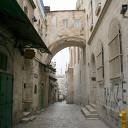
Jesus was crucified in Jerusalem, probably on April 7, 30 A.D. For Christians, the "Son of God" began a different era with his sacrifice announcing freedom from sin and death by his resurrection. In memory of Jesus, Christian pilgrims from all over the world walk the Via Dolorosa from Antonia, (Pontius Pilate's seat of government) to the Basilica of the Holy Sepulchre, (built on Golgotha, the "Hill of the Skull"). The Via Dolorosa is the route where the Christ carried the cross.
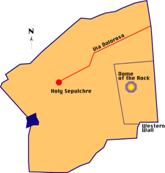
· First Station
Jesus is condemned to crucifixion. Pontius Pilate, under pressure from the High Priests and the crowd, passes the death sentence while trying to dissociate himself from this judgment by washing his hands.
· Second Station
Jesus bears the cross. Following flagellation, Jesus is crowned with thorns and clothed in purple as a mark of derision by the soldiers who along with crowd mocked the so-called "king of the Jews". Jesus departs for the place of execution outside the city gates.
· Third Station
Jesus falls for the first time. Jesus said to his disciples: "My life, no one shall take it from me, I who shall give it".
· Fourth Station
Jesus meets his mother. The prophecy Simeon made to Mary when Jesus presented himself at the temple is fulfilled: "thy son will be a sign of contradiction, and thee, a sword will pierce thy heart."
· Fifth Station
Jesus is helped by Simon of Cyrene. Simon is required to carry the cross at the side of Jesus; a gesture symbolizing the Christian conviction, "Thy brother is Christ".
· Sixth Station
Veronica wipes Jesus' face. The cloth Veronica used held the sweat of blood which covered Jesus' face.
· Seventh Station
Jesus falls for the second time.
· Eighth Station
Jesus consoles the women of Jerusalem. "Do not cry for me, cry rather for yourselves and your children" said Jesus.
· Ninth Station
Jesus falls for the third time.
· Tenth Station
Jesus is deprived of his clothes. Jesus speaks to his father through the words of the psalmist - "You wanted neither sacrifice nor obligation, you gave me one body, you did not agree on either holocaust or sacrifice, so I said, 'Here I am I come...'in order that thy will be done O lord."
· Eleventh Station
Jesus is put on the cross. Jesus words resound: "And I, raised from the earth, will draw all men to me." In these words he indicated the manner of his death.
· Twelfth Station
Jesus dies. The last testimony of Jesus who had said "the father and I are one" gave forth his terrible cry: "My God, my God, why hast thou forsaken me?". Then "Jesus cried with a loud voice, and gave up his ghost".
· Thirteenth Station
Jesus, is brought down from the cross, and placed in his mother's arms.
· Fourteenth Station
Jesus is placed in the tomb. With Passover starting that day, Joseph of Arimethea offered his tomb, where Jesus was placed. The stone was rolled on top.
· Haram El-Sharif
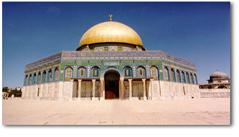
The most famous building in the Haram el-Sharif is the Dome of the Rock ("Qubbat el-Sakhra" in Arabic). This jewel of the Holy Land, casts the glory of its golden dome all over Jerusalem. The Dome of the Rock is an octagonal structure, superimposed on two squares offset by an angle of 45 degrees. Its layout, subject to complex geometry has made it a model for later Islamic architecture.
The dome is formed by two superposed cupolas, between which a space was worked in to protect the decoration from the climate. An epigraphic strip, 262 yards long, dedicated to the glory of Jesus, (a prophet according to Islam) runs around the drum. The rock in the middle of the dome, where Abraham prepared to sacrifice his son Isaac, symbolizes the center of the world in Muslim geography. The Faithful can make out the footprint of the Prophet, as well as the handprint of Gabriel. The cave under the rock is called the "Well of Souls', where tradition maintains the souls of the dead linger before disappearing. The external decoration of mosaics has been restored many times. Suleyman replaced the Omayyad and Ayyubid pottery with Persian ones. These were replaced in 1964 to Armenian glazed tiles, surmounted by a frieze with verses from the Koran.
The El-Aqsa Mosque was built between 705 and 715 at the southern part of Haram el-Sharif. The largest mosque in Jerusalem was destroyed several times by earthquakes and now has only a few elements of its original Omayyad structure. The main part of the building is the work of the Fatimid caliph of Egypt, El Zahir who restored the mosque in 1035. The Crusaders and the Ayyubids performed additional modifications to the mosque, making it a mixture of architectural styles.
The mosque was called El-Aqsa ("the furthest away" in Arabic) after the miraculous Night Journey of the Prophet Mohammad to Jerusalem as told in the Sura XVII: "Glory be to him who made His servant go by night from the sacred Temple to the farther Temple whose surroundings We have blessed."
The need to counterbalance the prestige of the Byzantine masterpieces, particularly the Holy Sepulcher, was all-important in the building of this monumental mosque. The seven arches of the portico echo the seven parts of the layout of the Holy Sepulcher.
· The Western Wall
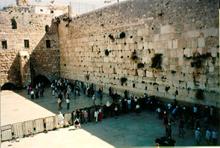
The Western Wall is the last of the remains of the ramparts that surrounded the Holy Temple of the Jews, built by Solomon and destroyed by Nebuchadnezzar, rebuilt by the Babylonian exiles and by Herod, and burned down by Titus. From the day after its destruction, Jews gathered to weep and pray on the ruins of the Temple. They later had to pay the Romans to pray there. When the cupola of the Dome of the Rock covered the ruins of the Temple, only one side of the holy structure remained. The Western Wall is the symbol of the Jewish people who believe the Shechina (Divine Presence) soars above it.
Most of the wall's huge stones come from the Second Temple, with the foundations dating back to the time of Solomon. Often referred to as the Kottel (Holy of Holies), the Western Wall is busy at the beginning of Shabbat and on the High Holy Days. Each year on the 9th of Av (July-August), the anniversary of the destruction of the Temple, tens of thousands of Jews gather at the Western Wall to say prayers of mourning.
· Ein Karem
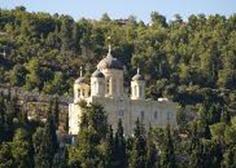
Ein Karem is a picturesque village located approximately 8 km southwest of Jerusalem. It is indirectly mentioned in the bible as home of St. Zacharia and his wife Elizabeth, and the birthplace of their son John the Baptist.
Mary who visited Ein Karem on the way to Bethlehem during her pregnancy, met her kinswoman Elizabeth, and stayed with her for 3 months following the visitation by the angel Gabriel in which he announced the future birth of Jesus "Elizabeth spoke out with a loud voice and said: Blessed art thou among women and blessed is the fruit of thy womb. And whence is this to me that the mother of my Lord come to me" (Luke 1:42).
· Church of the Visitation
This church,
beautifully located on the slopes of a rocky hill and shaded by cypresses, is
also known as the Church of the Magnificat (Mary's song in Luke 1:46-55), in
commemoration of the answer Mary gave her cousin Elizabeth in the Gospel episode
of the Visitation. Her hymn to the glory of the Lord is inscribed in 41
languages on one wall of the church.
The present Basilica is a Franciscan church designed by the Italian architect Antonio Barluzzi and built between 1938 and 1955. The Franciscan Order had acquired the land as early as the second half of the 17th century. The construction work revealed the remains of earlier, more ancient sacred buildings; in particular, vestiges of a church of the Byzantine era and of a similar building raised by the Crusaders in the 12th century were found.
In front of the Church of the Visitation, which is entered through an artistic wrought-iron gate, is a low portico topped by a graceful bell tower. This building consists of two parts. In the so-called Upper Church, religious services are held, while in the Crypt a cave is found in which a miraculous spring broke forth at the exact moment when Elizabeth welcomed the Virgin.
Among other curiosities, it is worth mentioning a stone against one wall, which bears the imprint of a young boy's body. Traditionally, it is believed that the infant John left this imprint, when Elizabeth hid him from Herod's soldiers at the time of the slaughter of the Innocents.
· Church of St. John the Baptist
The Church of St. John
the Baptist belongs to the Franciscan monastery of the same name. The first
church rose here in the 5th century, over the place traditionally held to be the
home of St. Zacharia and Elizabeth. Enlarged by the Crusaders and later used by
arabs as a caravanserai and stable, the church was rebuilt and transformed
several times.
The latest
additions, carried out by the Franciscans, date from the 2nd half of 19th
century and from the thirties of last century. The most striking part of the
pleasantly adorned interior is the Crypt, which houses the so-called Grotto of
the Benedictus (Zacharia's song in Luke 1:68-79), considered being the place
where John the Baptist was born. A marble star beneath the altar bears a Latin
inscription: "HIC PRECURSOR DOMINI NATUS EST" (Here was born the precursor of
the Lord).
· The Knesset

The Knesset, Israels parliament, is a single-chamber, 120-member legislature. The Knesset takes its name and the number of its members from the Knesset Hagedolah, the representative Jewish body convened in Jerusalem by Ezra and Nehemiah in the 5th century BCE.
The Knesset is the supreme legislative authority in the State. The Government takes office after formal approval by the Knesset, and must resign if a no-confidence vote by a majority of Knesset members passes in the plenum. The Knesset also elects the President (the head of state, whose tasks are mainly ceremonial) by a majority of its members.
Daily tours: Sunday & Thursday: (English) 08:30, 12:00, 13:45
On Mondays, Tuesdays & Wednesdays it is possible to listen to discussions. It is necessary to reserve a sit. Contact number: 02ý-675ý-3538
Dress code: It is prohibited to wear sleeveless clothing, shorts, jeans or sandals.
· The Supreme Court

The Supreme Court is at the head of the court system in the State of Israel. It is the highest judicial institution and sits in Jerusalem. The area of its jurisdiction is the entire State. A ruling of the Supreme Court is binding upon every court, other than the Supreme Court itself. This is the principle of binding precedent in Israel.
Opened in 1992, the building is a serious attempt to come to grips with the local building tradition. It makes rich and wide-ranging references to the whole lexicon of Israel building over the centuries, starting with Herodian structures, through the Hellenistic tomb of Absalom, the Crusaders, Greek Orthodox monasteries, and up to the British Mandate period. These different styles are organized in a complex, almost baroque structure, built out of contrasts light-shade, narrow-wide, open-closed, stone-plaster, straight-round, and a profusion of existential experiences.
It was written in the New York Times that it is "Israel's finest public building" achieving "a remarkable and exhilarating balance between the concerns of daily life and the symbolism of the ages".
Daily tours: (English) 12:00
· Jaffa Road

Jaffa Road is one of the longest and oldest streets in Jerusalem. It crosses the city from east to west, from the Old City walls to downtown Jerusalem, the western portal of Jerusalem and the Jerusalem-Tel Aviv highway. It is lined with shops, businesses and restaurants. Major landmarks along Jaffa Road are Tzahal Square (IDF square), Safra Square (city hall), Zion Square, Davidka Square, the "Triple" intersection (Hameshulash) at King George V Street and Strauss Street, the Ben Yehuda street pedestrian mall, the Mahane Yehuda market, and the Jerusalem Central Bus Station. Jaffa Road is currently being redeveloped as a car-free pedestrian mall served by the Jerusalem Light Rail.
For much of its hundred year existence, Jaffa Road has served as Jerusalem's central artery. In recent years, the municipality has responded to problems in the struggling city-centre through focused efforts to redevelop the street; Jaffa Road has been limited to public transport (buses and taxis) in an attempt to divert traffic congestion from the area, and it is the centrepiece of a new development plan for revitalizing downtown.
· Ben Yehuda Street & Zion Square

|
Ben Yehuda Street is a major, busy street in downtown Jerusalem. It is located where Jaffa Road and King George Street meet at one end with Zion Square. The street is named after the founder of modern Hebrew, Eliezer Ben-Yehuda. Many souvenir shops are to be found on this pedestrian mall in the non-transportation street. In the summer (July-August) different festivals take place all along the street, such as a wine festival, a food festival and a local music festival.
Zion square is the located at the bottom of Ben Yehuda street and it combines three main streets: Ben Yehuda, Jaffa and Yoel Solomon street. The square is named after the Zion cinema, established in 1912. The cinema was destroyed in 1972 and today “Zion Square Hotel” is there instead. The square is known as a meeting place of the Jerusalem’s young population.
· Nachalt Shiv’a
Nachal Shiv’a is an old neighborhood in the center of Jerusalem, established at the end of the 19th century. The neighborhood is named after its seven (shiv’a) founders and was the third place in Jerusalem to be populated outside the old city, after Mishkenot Sha’ananim and Machane Yehuda.
The main street of the neighborhood is “Yoel Solomon Street” and is full of art shops, souvenirs, restaurants and pubs. Among the little allyways are beautiful houses and balconies. Nachalat Shiv’a is an example of a renovated neighborhood. The streets were cleared and floored, warehouses were renovated, facades were cleaned and the area turned into a one of Jerusalem’s most visited places.
The restaurant and book shop, “Tmol Shilshom”, one of the oldest houses in the area, is known for its Jerusalem atmosphere. It holds literary evenings, political debates and different lectures and events. This restaurant is hard to find since it is located within the magical allyways.
· Mahane Yehuda Market

Mahaneh Yehuda, often referred to as the 'Shuk', is an outdoor marketplace in central Jerusalem, stretching between Jaffa Road and Agrippas Street.
The market was established at the end of the 19th century. The Farmers used to sit under a huts and within 15 years those huts became constant wooden structures. With time, the market was renovated and today, apart from fresh fruits and vegetables, one can purchase baked goods, fish, meat, prepared food, spices, clothing, and shoes, house wares, textiles and even Judaica. On Thursdays and Fridays, the marketplace is bustling with shoppers stocking up for the weekend.
Bethlehem

Bethlehem - Beit Lahem in Arabic ("The house of Lahman - a Canaanite God") - is about 6 miles south of Jerusalem. Its population used to be exclusively Christian but is nowadays a mix of Christian and Muslim Palestinians. Bethlehem is the home of the Nativity Church (Basilica of the Nativity), built above the cave where Jesus is said to have been born. Poor Bethlehem families used the region's rocky hollows as dwellings and stables making the 2nd century Christian tradition which places the nativity in a cave plausible, even though Western teachings mention the birth of Jesus in a manger.
The original sanctuary of Nativity Church was built in AD 323 by the Emperor Constantine, at the request of his mother, Saint Helen who supervised the work in AD 326. Nothing remains of the first building except the nave and its four rows of columns. Every year, Bethlehem is filled with Christian pilgrims who are warmly welcomed. The city is busiest on Christmas Eve with the traditional Christmas mass. Southeast of the Basilica, is the Milk Grotto, where according to tradition, the Holy Family stayed before fleeing to Egypt. The walls of this cave were reputed to possess the properties for making suckling easier. In the 19th Century, a church was built by the Franciscans over the chapel, dating back from pre Christian times, from above the cave.
Nearby are the Shepherd's Fields (Beit Sahour), where it is believed the Shepherds of the Nativity came. Also in this location are ruins of a Byzantine monastery built on top of important military relics from the Herodion period.
Bethlehem is currently under sovereignty of the Palestinian Authority. Olive wood souvenir are the main product of this city along with olives, olive oil and of course tourism.
North & surroundings
· Nazareth
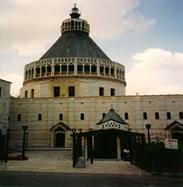
Nazareth is home to the largest Arab community inside of Israel. During the 1950's the city saw an influx of Jews who settled in the new quarter of Nazareth Illit. Nazareth is dotted with churches, convents and monasteries that have been built since the 6th century. The most known landmark in Nazareth is "The Basilica of The Annunciation", a Franciscan church dating back to 1730. In 1955, it was destroyed to give way to a new building completed in 1969. The site was excavated, the results of which are on view in the Franciscan Museum within the walls of the church. The church covers the traditional site of the Virgin Mary's house, the Virgin's cave, where the archangel Gabriel appeared to Mary to herald the birth of Jesus as described by Luke: " The angel Gabriel was sent from God unto the city of Galilee, named Nazareth, to a virgin espoused to a man whose name was Joseph, of the house of David; and the virgin's name was Mary".
A small sanctuary is dedicated to Conon, a 3rd century martyr originally from Nazareth and a member of Jesus' family. Graffiti on the wall has made it easier to understand Judeo-Christians, Jesus' first disciples. The church is also covered with magnificent art from all around the world. Across from the square is St. Joseph's Church built over the cave thought to be Joseph's house. The Greek-Catholic Church, in the center of the suq (market), is the site of the synagogue where Jesus is said to have preached as a young man. Uphill on Paul VI Street, you come to Mary's Well, the water of which is said to heal all ailments. Further uphill, you come to St Gabriel Greek Orthodox Church, which stands over the town's original water source.
· Caesarea
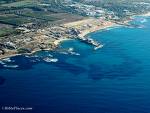
Caesarea is an ancient Crusader site halfway between Jaffa and Haifa on the
Mediterranean coast. Long forgotten after the 13th century, it was uncovered by
archeologists in the 1950's. Caesarea was built on the site of a Phoenician port
whose tower was kept by the Greeks. It was named after Caesar Augustus and in 30
BC Octavious (Julius Caesar's grandson) gave the site to Herod, on which the
port town would be built.
The Archbishop of Caesarea, Eusebius wrote the Onomastikon in Greek there. It is
the first geography of Palestine. In 612 AD Caesarea fell under Persian rule,
followed by Arab rule in 640 AD. In 1101 AD, the city fell to the Crusades who
proceeded to massacre its population. The crusaders were forced to abandon the
city to Salah al-Din in 1187 , but recaptured it in 1228. After the Mamelukes
recaptured the city in 1265, Caesarea fell into oblivion. In 1878, the Ottomans
settled a Muslim community from Bosnia in Caesarea. This community of fishermen
was destroyed in 1948. Excavations followed and discoveries were numerous.
· Tiberias and the Galilee
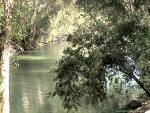
The Sea of Galilee is located about two hours and a half north of Jerusalem and can be reached via the Jordan Valley or through Nazareth. The main city on the Sea of Galilee is Tiberias.
It was here, Jesus walked on water and performed The Miracle of Loaves and Fish. On the Mt. of Beatitudes, he conducted The Sermon of the Mount. Tiberias was built on the ruins of an old Jewish cemetery, and was founded in AD 19 in homage to Emperor Tiberius. Tiberias is best known for its hot springs with its medicinal properties at and its fish known as St. Peter's fish.
On the northern shores of the lake one can find Capernaum, Christ's own town. Located here is Saint Peter's house in which Jesus lived while his apostle was lodged with his in-laws at Bethsaida. The house is now covered by a church with basalt walls while still showing the first century walls.
Jericho and surroundings
· Jericho
Also known as Ariha in Arabic, it stretches out about a mile east of the tale of ancient Jericho. This biblical city dates back to 10,000 years, and is most famous for the fall of its walls, caused by the holy ram's horn trumpets blown by Joshua's priests. Jericho was the first city to be conquered by the Hebrews after the Exodus. It was razed to the ground and cursed, then rebuilt by Ahabin the 9th century BC. It was later fortified by the Maccabees. Jesus passed through Jericho several times during his ministry, including the time he cured two blind people.
Jericho's population of 17,000 work in local businesses and agriculture, and particularly in the refugee camp of Aqabat el-Jar to the south of the city. The tropical vegetation offers what might be the best citrus fruit and bananas in the world.
|
Qasr Hisham (Hisham's Palace) is located on the north bank of Wadi Nueima just outside Jericho. The palace, named after the eighth Omayyad caliph was built during his reign between 724 and 743 AD. It was inhabited by his heir, El Malik II during the winters. The palace is an excellent example of Islamic art and architecture of the eighth century. In 747, the palace was destroyed by an earthquake. |
|
|
After his baptism in the Jordan river, "Jesus was led into the desert by the Holy Ghost to be tempted by the Devil" (Mathew 4). Jesus fasted for 40 days and 40 nights before being tempted three times by the Satan. According to lore, a mountain west of Jericho is the one which Jesus triumphed over the tempter. The Crusaders called it the "Mount of Forty" while Arabs call it Deir el Qarantal). At the peak is a Greek Orthodox Monastery restored in the 19th Century on the ruins of a Byzantine church. Its foundations contain the cave in which Jesus stayed for forty days. |
|
|
|
Located in the narrow canyon of Wadi Kelt, the blue domes of one of the oldest monastic communities of the Holy Land pierce the arid landscape. Since the beginning of Christianity, these cliffs full of caves have been a refuge to hermits. The monastery's present buildings date back to the 19th century, but has been occupied since the 5th century. The monks do allow visitors and will willingly act as guides. the most spectacular attractions are the 6th century mosaics in the floor of the church of St John. Travelers who walk from Jerusalem to Jericho following bed of Wadi Kelt should be in good physical shape and have plenty of water for the trip through the desert. |
The Dead Sea and surroundings
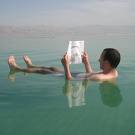
The Dead Sea is the lowest point in the world at 1300 feet below sea level, and fills a natural basin formed by the Syria-African fault. This large salty lake is fed by water which springs from the hills from the north and is swollen by the streams of water in the hills that surround it from the east and west. The Dead Sea varies in depth from 130 feet in the north to 30 feet in the south. In the summer, the water level can go down by several feet due to evaporation. The waters of the Dead Sea are ten times saltier than the Mediterranean's, and as such prevent the existence of any complex ecosystem. In the Bible, it is a symbol of sterility and misfortune.The Dead Sea is rich in phosphates, crucial to the economies of Israel and Jordan.
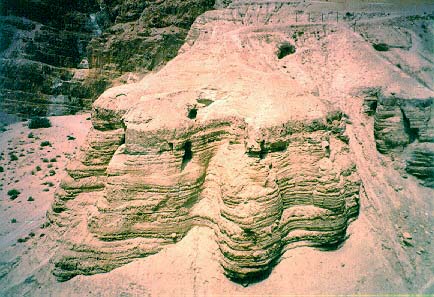
Between 1947 and 1956, some eight hundred manuscripts, a dozen of which are almost complete, from the library of the Essene "monastery" were found in eleven caves all situated to the north of Wadi Qumran. In 1947, a Bedouin who had wondered in one of the caves found an earthen jar containing seven manuscripts, broken or empty jars and the remaining seventy four manuscripts. Among these manuscripts, with paleographic dating extending over roughly three centuries (from 250 BC to AD 50) are all the Biblical books except for Esther, the non-Canonical books and Essene writings. Most of the texts, written on scrolls (leather, papyrus or copper), were copied at Qumran by scribes. The oldest scrolls date back to the 3rd century BC. Nearly all the manuscripts are preserved in Jerusalem at the Rockefeller museums. The ruins of Qumran which were excavated in 1952-56, revealed that the site had been the base of the Essene community from 152 BC to AD 68. The Essences led a communal life of asceticism, prayer and expiation in a "monastery" built on the remains of a small Judean fort dating back to the end of the 8th century BC.

The rock of Masada rises 1,300 feet above the west bank of the Dead Sea at the edge of the Judean Desert. The summit which is 1,900 feet long and 650 feet wide, can be reached via a "snake path" or cable car. The Roman Ramp, which is less steep, can be reached by a road coming from Arad.
Masada is a significant landmark in Jewish history. It is here that Herod took refuge in 40 BC to escape from his rival Mathias Antigone, the legitimate heir to the Hasmonean dynasty. He returned to fortify it after he was made king by the Romans in 37 BC. The fortification was prompted by fears of attacks from Cleopatra, the queen of Egypt. In 6 AD, Masada was made into a Roman garrison, falling to the Sicarii nationalists in 66 AD. Eleazar, Yair's son, led the stronghold from 67 to 73 AD. In the spring of 73 AD, Flavius Silva established camp at the northeast corner of Masada. In April of 73 AD, Silva's 9000 soldiers began their assault on the rock using catapults, rams and other war machines. Seeing that all was lost, the defenders chose death over slavery to the Romans. In the morning following the assault, the Romans discovered 960 bodies. Two women and five children who survived told Flavius about the last minutes of the defenders. The testimonials were later reproduced in book XII of “The Wars of the Jews”.
Copyright © 2009 AYA Tours. All rights reserved